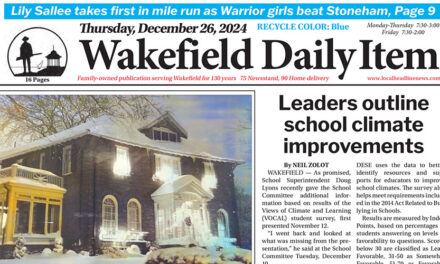
TOWN MEETING votes to move the question on Article 4 Saturday. (Frank Conte Photo)
WAKEFIELD — A request to change zoning bylaws to allow a multi-family housing by right zone to comply with a state directive for communities serviced by the MBTA was passed at the Regular Town Meeting Saturday, November 16 in the Galvin Middle School.
The total area designated for the new zoning is smaller and more spread out than proposals made at the Annual Town Meeting last spring and are in some areas in which there are already multi-unit dwellings.
“It rezones areas where we already have multi-unit dwellings that were approved by Special Permits for minimum compliance,” Town Councilor Jonathan Chines explained. “In essence, we’re crediting those areas.”
“There were a lot of requests to capture existing development,” Senior Town Planner Samantha Elliott said about public input since the Annual Town Meeting.
Rather than concentrate the new zones around the downtown and the North Avenue commuter rail station, they are in various areas around town. The smaller area downtown will be along North Avenue and Albion Street, and along Foundry Street, which was not in the previous plan.
Other zones will be near the Greenwood transit station, which was discussed last spring, and cover large buildings on Audubon Road, near the intersection of Route 128 and Salem Street. “It’s different from what we had in the spring,” Town Council Chairman Michael McLane pointed out.
The areas meet the requirement for a contiguous zone because the areas are close enough to meet volume requirements close to transit stations despite the fact they’re not in one concentrated area.
“It’s clear we’re talking about a singular contiguous district,” Town Counsel Thomas Mullen answered when resident Scot McCauley brought up the matter.
Elliott went over the plans for the 543 people in attendance, concentrating on the need for housing and on the location and character of the zones. For instance, the North Avenue area is characterized as a Mixed Use Area, and Albion and the Greenwood area as a Neighborhood Commercial Area, in part because there is already multi-unit housing there, but she also discussed how non-compliance would affect grants. She said it is impossible to calculate the effect because non-compliance would affect grants in the future which have yet to be determined. Presumably that could have affected aid for rebuilding rehabilitating the Greenwood School.
“I don’t want to lose grant money, which would be a result of this not passing,” McLane chipped in. “We have a healthy town budget, but a lot of that money is spoken for.”
Elliott also told the body most communities in the area have adopted new zoning to comply with the directive.
The final vote was 309 for the new district, 204 opposed.
“Growth is going to happen and we should be planning ahead,” Eric Wages said in discussion from the floor. “I prefer this plan to the others. We’re talking about areas already built up.”
“It’s minimal compliance in a small area,” Eleanor Axelrod added.
“It’s a terrific plan and a way for us to maintain control of this,” Stacey Constas feels. “If you don’t think the state will sue us and make us go through with this, think again. This is for zoning only. There’s no guarantee there’ll be loads of people coming in and a lot of aid is at risk.”
Addressing the often used argument — development will lead to overcrowding in the schools — Sam Hockenbury, also a member of the Capital Planning Committee and Housing Production Plan Advisory Committee, said that hasn’t happened in Burlington where he works as a financial analyst. “It yields only a small number of students,” he said.
Jim Hogan of the Planning Board and Tiana Veldwisch of the Environmental Sustainability Committee also spoke in favor of the plan. “While this may not be perfect, we feel it represents a quality compromise,” Hogan said in reference to the spring proposals.
“We can’t afford to pass this,” Robert McLaughlin had said earlier. “The capacity in the schools isn’t there. I don’t want to see one inch rezoned by people in the State House. We have more knowledge than they ever will.”
“They can’t take control of zoning until we vote it,” McCauley picked up. “Otherwise they would have told us to just do it.”
Robert Mitchell advised a no vote. “Right now there’s a balance of power between the town and the state,” he said. “We have a little power in that. I believe there are many ways the state can encourage housing, but I’m against the way it’s being done. I feel I’m being bullied by the State House. We can come back to this. Let’s see how the Supreme Judicial Court ruling comes down. The state will accommodate us. They don’t want to sue hundreds of thousands of people,” a reference to some communities taking legal action against the mandate.
“It’s incorrect to say we’re not required to do this,” Mullen reacted, pointing out the state regulations indicate MBTA communities “shall” have the zoning. “How we do it is up to us.”
Christopher Bossi argued, “The state can restrict the zoning power of towns; the state has the ultimate authority on zoning. This meeting doesn’t have the authority to take the town to war with the state.”
He also asked, if so many people were against the idea, why no one had challenged state senators and representatives who voted for it. “If there’s such a groundswell of support against this, I wonder why there haven’t been challenges to the senators and representatives who supported it.”
He then pointed out Town Councilor Ed Dombrowski unsuccessfully challenged State Senator Jason Lewis in 2022, but both support the new zoning. In the spring Dombrowski offered a variation on the plan presented at that time, but Town Meeting rejected the idea in its entirety.
In a seemingly contradictory argument, McCauley warned state authorities would impose a multi-unit by right zone or zones if Town Meeting didn’t pass the article, which seemed to have echoed Mullen’s argument to pass it.
McCauley tried to upend approval by requesting a paper or secret ballot for the vote, which led Town Clerk Betsy Sheeran to inform Moderator William Carroll a vote for a secret ballot had to be conducted by secret ballot, which Mullen confirmed. “The Charter provides a secret ballot requirement for a secret ballot,” he said. “A vote on a motion for a secret ballot shall be by secret ballot.”
In discussion on that matter only, McCauley said some people might feel intimidated by a public show of hands. Chines argued not to for the “sake of expediency. It will just take time.”
McLane added no one seemed embarrassed or intimidated in speaking on the matter in public.
After some groans from the assembled during debate, McCauley withdrew his motion, which elicited applause.
There had been two earlier motions to “call the question.” The first, which was defeated, was about a third of the way into the discussion, the second, which passed, not long before the vote. Some people who voted against calling the question in the early vote, voted to call the question in the latter vote, apparently feeling the matter had been discussed enough.
A lot of people stayed for the remainder of the meeting, but a lot of people also left immediately.





